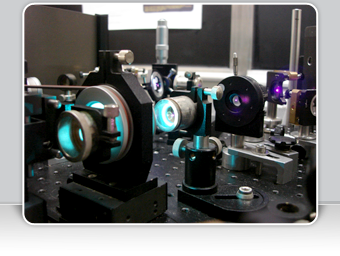« Back to all publications
Download this list in a RIS file or a BIB file or a PDF file
|
||||||||
A study of the dynamics of electronic energy transfer (EET) in arrays containing three, four, and six tetraphenylporphine units connected with phenylethynyl spacers is reported. For arrays containing the same chromophores, the EET rate constant was determined from the reorientational dynamics of the transition dipole using the crossed grating technique. EET time constants ranging from 150 ps up to 33 ns were measured, depending on the distance between the chromophores and on the metal ion complexed in the porphyrins. For the trimeric planar arrays, the interchromophoric distance varies by a factor of 2, while the ratio of the through space to through bond distances is constant. By comparing the measured EET rate constants with those calculated using Förster theory, the contributions of the Coulombic, through space, mechanism and of the exchange, through bond, mechanism could be estimated. For the arrays with the shortest spacer (through space distance of 23 Å), EET occurs through both exchange and Coulombic interactions with a ratio of about 3:1. This ratio increases up to about 10 as the distance is increased to 34.5 Å. At 46.5 Å, the ratio decreases and it appears that the Coulombic interaction becomes the dominant mechanism at longer distances. In the tetrahedral compound, the presence of a central saturated carbon strongly alters the electronic conducting properties of the spacer and makes the exchange mechanism inoperative. | ||||||||
|
||||||||
The deactivation of the S1(π,π*) excited state of nickel tetraphenylporphine has been investigated using various transient grating techniques. By measuring the density changes of the sample occurring during this process, the excited state, that is responsible for the ground state recovery time of 250 ps, was determined to lie 1.18±0.13 eV above the ground state. This value suggests that this state is the1(d,d) state. | ||||||||
|
||||||||
The solvation dynamics of an organic dye, IR140, in methanol, ethanol, and in a series of six alkanenitriles has been investigated using the transient grating technique. In all solvents, the dynamics exhibit ultrafast, almost solvent-independent, components ascribed to inertial solvation, and a slower viscosity-dependent component, due to diffusive solvation. The relative amplitudes of these components depend on both the solvent and on the wavelength at which the experiment is performed. The contribution of inertial motion increases with decreasing size of the solvent molecules and with decreasing wavelength. It appears that diffusive motion is associated with a loose solvent shell, while inertial motion dominates when the solvation layer is dense. | ||||||||
Download this list in a RIS file or a BIB file or a PDF file
Contact:
Eric Vauthey
Physical Chemistry Department - Sciences II - University of Geneva
30, Quai Ernest Ansermet - CH-1211 Geneva 4 (Switzerland)
© All rights reserved by Eric Vauthey and the University of Geneva
Design and code by Guillaume Duvanel




